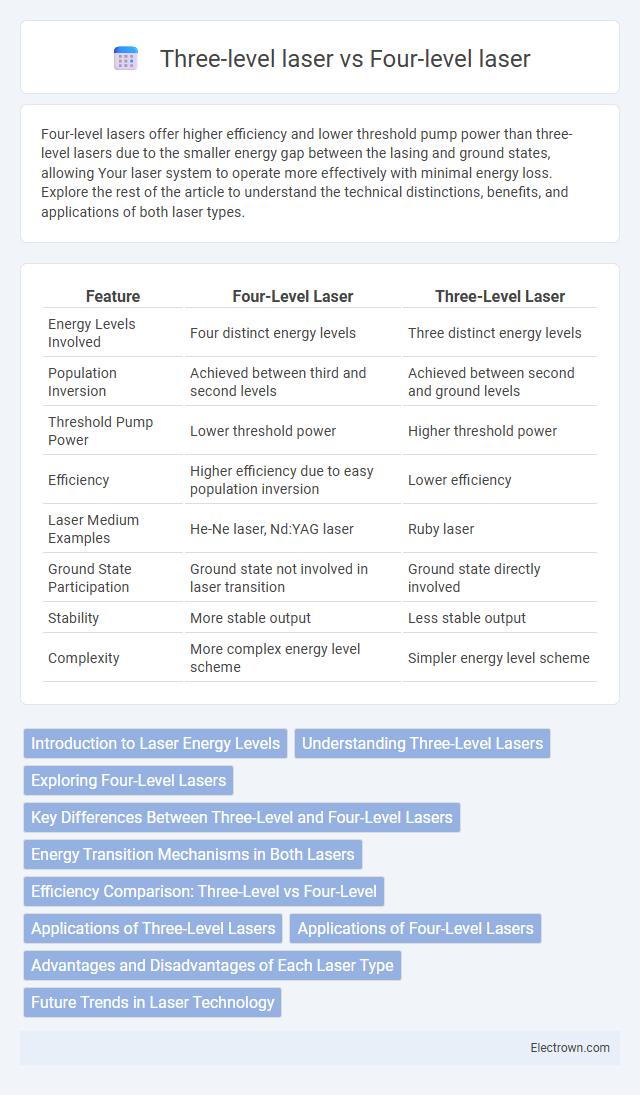Four-level lasers offer higher efficiency and lower threshold pump power than three-level lasers due to the smaller energy gap between the lasing and ground states, allowing Your laser system to operate more effectively with minimal energy loss. Explore the rest of the article to understand the technical distinctions, benefits, and applications of both laser types.
Table of Comparison
| Feature | Four-Level Laser | Three-Level Laser |
|---|---|---|
| Energy Levels Involved | Four distinct energy levels | Three distinct energy levels |
| Population Inversion | Achieved between third and second levels | Achieved between second and ground levels |
| Threshold Pump Power | Lower threshold power | Higher threshold power |
| Efficiency | Higher efficiency due to easy population inversion | Lower efficiency |
| Laser Medium Examples | He-Ne laser, Nd:YAG laser | Ruby laser |
| Ground State Participation | Ground state not involved in laser transition | Ground state directly involved |
| Stability | More stable output | Less stable output |
| Complexity | More complex energy level scheme | Simpler energy level scheme |
Introduction to Laser Energy Levels
Four-level lasers operate with a wider energy gap between the pump and laser emission levels, resulting in higher efficiency and lower threshold energy compared to three-level lasers. In three-level lasers, the laser transition occurs between the same lower energy level that is also the ground state, causing greater reabsorption of emitted photons and thus requiring more energy to achieve population inversion. The improved energy-level scheme in four-level lasers minimizes ground-state absorption, enabling more effective laser action and continuous operation at lower pump power.
Understanding Three-Level Lasers
Three-level lasers operate by exciting electrons from the ground state to a higher energy level, requiring a significant population inversion to achieve lasing, which makes them less efficient compared to four-level lasers. The lower laser level in three-level lasers coincides with the ground state, leading to a greater threshold pump power to maintain population inversion. Understanding these dynamics is crucial for optimizing laser performance in applications like ruby lasers and certain solid-state lasers.
Exploring Four-Level Lasers
Four-level lasers offer higher efficiency and lower lasing threshold compared to three-level lasers due to their more effective population inversion process. In four-level systems, the laser transition occurs between the third and fourth energy levels, allowing rapid depopulation of the lower lasing level, which minimizes reabsorption and increases output power. Exploring four-level lasers reveals advantages in applications requiring stable and high-intensity laser emission, enhancing Your choices in advanced photonics technologies.
Key Differences Between Three-Level and Four-Level Lasers
Four-level lasers feature an additional energy level above the ground state, allowing electrons to return to a quickly depopulated lower laser level, resulting in higher efficiency and lower threshold pump power compared to three-level lasers, where the lower laser level is the ground state. The population inversion in four-level lasers is easier to maintain, enhancing output stability and making them more practical for continuous-wave operation. Your choice between these lasers depends on factors like required output power, efficiency, and complexity of the laser system design.
Energy Transition Mechanisms in Both Lasers
Four-level lasers involve energy transitions where electrons drop from the upper laser level to a slightly lower metastable state before returning to the ground state, enabling more efficient population inversion and lower threshold pump power. In contrast, three-level lasers have electrons transition directly from the excited state to the ground state, requiring higher pump energies to achieve population inversion since the ground state is heavily populated. The distinction in energy transition mechanisms impacts laser efficiency, thermal management, and output power stability in various laser applications.
Efficiency Comparison: Three-Level vs Four-Level
Four-level lasers exhibit higher efficiency compared to three-level lasers due to their lower threshold pump power and reduced reabsorption losses. In three-level systems, the laser transition terminates on the ground state, requiring significant population inversion and resulting in higher pump power consumption. Four-level lasers maintain the lower laser level above the ground state, enabling easier population inversion and allowing for greater output efficiency and stable continuous-wave operation.
Applications of Three-Level Lasers
Three-level lasers, often utilizing materials like ruby, are commonly applied in solid-state laser systems for medical procedures such as tattoo removal and dermatological treatments. Their shorter wavelength emissions enable precise targeting in applications like holography and laser spectroscopy. Despite lower efficiency compared to four-level lasers, three-level systems remain valuable in fields requiring high-intensity, pulsed laser output.
Applications of Four-Level Lasers
Four-level lasers are widely used in medical procedures, telecommunications, and precision manufacturing due to their higher efficiency and lower threshold compared to three-level lasers. Their ability to achieve continuous-wave operation and produce stable, high-power output makes them ideal for applications like laser surgery, fiber-optic communication, and laser cutting. The improved population inversion dynamics in four-level lasers enable better performance in environments requiring consistent and reliable laser output.
Advantages and Disadvantages of Each Laser Type
Four-level lasers offer higher efficiency and lower threshold pump power compared to three-level lasers, making them suitable for continuous-wave operation and stable output power; however, they require more complex energy level schemes and precise material properties. Three-level lasers are simpler in design and easier to implement but suffer from higher threshold energy and lower efficiency due to reabsorption losses at the lasing wavelength. The trade-off between complexity and performance dictates the choice of laser type based on application requirements such as power output, wavelength stability, and operational efficiency.
Future Trends in Laser Technology
Four-level lasers exhibit higher efficiency and lower threshold power compared to three-level lasers, making them ideal for advancing high-precision applications such as medical diagnostics and quantum computing. Emerging laser technologies emphasize compact designs and novel gain media, with four-level systems leading innovations in tunability and pulse stability. Integration of semiconductor materials and nanostructures is expected to accelerate the development of next-generation four-level lasers for ultrafast and energy-efficient photonics.
Four-level laser vs Three-level laser Infographic

 electrown.com
electrown.com